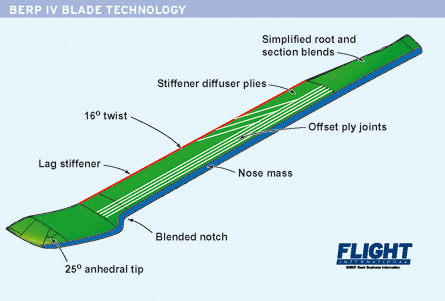Manufacturer says blade improves rotor flight-envelope performance and reduces power needs and vibration
A new main-rotor blade developed under the fourth British Experimental Rotor Programme (BERP IV) will provide a 600kg (1,320lb) payload increase for the UK Royal Air Force's EH101 Merlin medium-lift helicopter, says prime contractor AgustaWestland.
After 29h of a planned 35h flight-test programme, the Finmeccanica company says the BERP IV blade has been shown to improve rotor flight-envelope performance, reduce power needs in hover and forward flight, and decrease airframe and engine vibration for a range of take-off weights. Rotor hub loading has been found to be the same or less than with the BERP III blade now fitted to the EH101.
Six EH101s purchased from the Danish air force for modification to RAF Merlin HM3As are to be fitted with BERP IV blades, which are also planned for the US101 variant under development as the next US presidential helicopter.
BERP IV, funded 50:50 by AgustaWestland and the UK Ministry of Defence, aims to build on BERP III's combination of a high-lift aerofoil and high blade angle-of-attack without stall. The BERP IV blade uses a new aerofoil, revised tip shape and increased blade twist for lower hover power.
The new blade has 16e_SDgr of twist, a blended notch and a 25e_SDgr anhedral tip for better forward flight. A series of low pitching-moment aerofoils are used along the length of the blade, with simplified root and section blends. Because high twist increases vibration, aero-elastic tailoring using offset composite ply joints, coupled with rotor mass and stiffness distribution, is used to ensure blade deflection ameliorates the problem.

The BERP IV blade will also use rubber-based tape from 3M to counter leading-edge erosion. Under sand-blasting tests the material lasted for 195min. Polyurethane tape, used by UK Royal Navy Sea Kings, lasted 39min.
Flight testing began last September using the US101 demonstrator, designated CIV001 (Flight International, 3-9 October 2006). Since January an RAF Merlin HM3, designated RAF01, has been used.
BERP IV will officially end in August when AgustaWestland submits its final report. It is the last in a series of BERP programmes, which started in the 1970s. "We are working on a strategy to bring [internal, European and UK government projects] all together. BERP has been about passive technologies. Active technologies are of interest to us now," says AgustaWestland's BERP IV programme leader, Rob Harrison, speaking at the Royal Aeronautical Society in London.
BERP IV is being considered for the British Army and Royal Navy Future Lynx helicopter, for which AgustaWestland's UK arm is prime contractor.
Source: Flight International



















